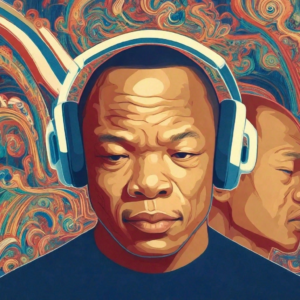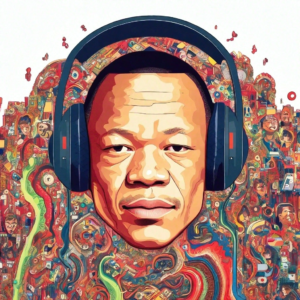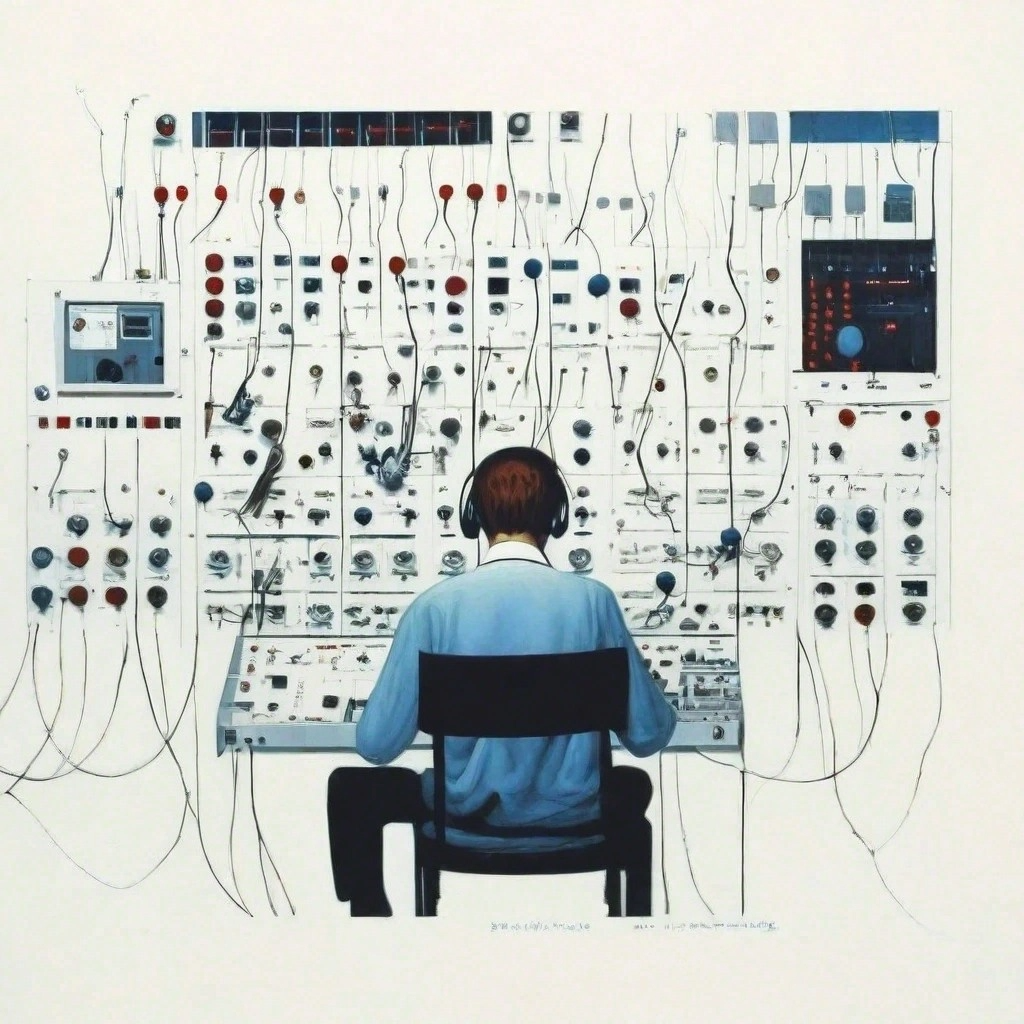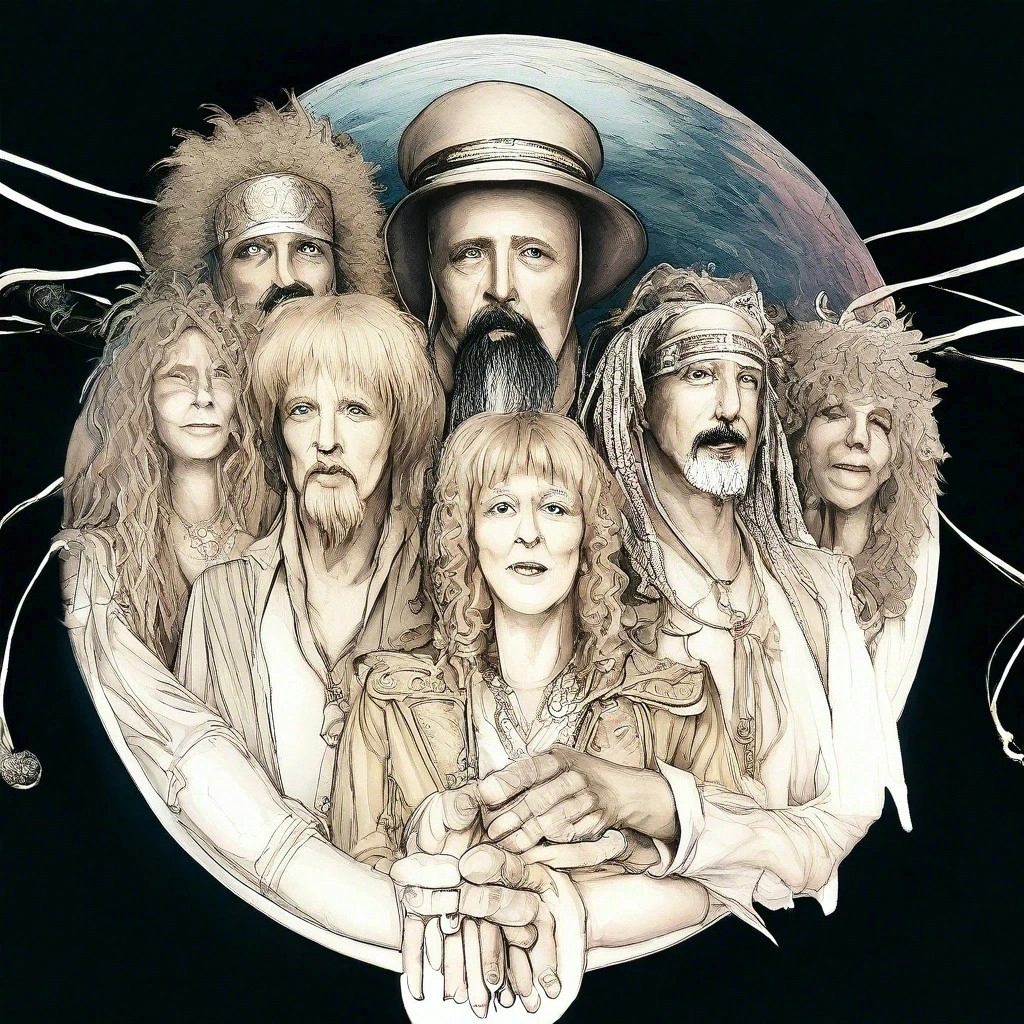The Chronic," Dr. Dre's seminal debut solo album
“The Chronic,” Dr. Dre’s seminal debut solo album released in 1992, is not just a cornerstone of West Coast hip-hop but a landmark in the genre’s history that reverberates throughout the entire landscape of rap music. Its impact transcends time, solidifying Dr. Dre’s status as one of the most influential figures in the history of hip-hop.
At the heart of “The Chronic” lies its revolutionary production, a sonic masterpiece that redefined the sound of hip-hop. Dr. Dre’s innovative use of sampling and production techniques introduced a new level of sophistication and artistry to the genre, setting a standard that would influence generations of producers to come. From the infectious funk-infused beats of tracks like “Nuthin’ but a ‘G’ Thang” to the laid-back grooves of “Let Me Ride,” the album’s production is a testament to Dre’s unparalleled skill and creativity behind the boards.
But it’s not just the production that sets “The Chronic” apart; it’s also the masterful lyricism and storytelling that infuse every track with depth and substance. Dr. Dre’s introspective verses offer a raw and unfiltered glimpse into life in South Central Los Angeles, tackling themes of street life, gang culture, and social injustice with honesty and authenticity. From the hard-hitting commentary of “The Day the Niggaz Took Over” to the poignant reflections of “Lil’ Ghetto Boy,” Dre’s lyricism is as thought-provoking as it is impactful, resonating with listeners on a deeply personal level.
Moreover, “The Chronic” features groundbreaking collaborations with some of the most iconic voices in hip-hop, further elevating its status as a landmark album in the genre’s history. Snoop Dogg’s smooth delivery and charismatic presence on tracks like “Nuthin’ but a ‘G’ Thang” and “Dre Day” helped to solidify his status as a rap superstar, while guest appearances from artists like Tha Dogg Pound and RBX added layers of depth and complexity to the album’s sonic tapestry.
From its iconic cover art to its innovative sound, “The Chronic” remains a timeless classic that continues to shape the landscape of hip-hop. Its influence can be heard in the work of countless artists who have been inspired by its groundbreaking production, masterful lyricism, and groundbreaking features. Truly, “The Chronic” is not just an album; it’s a cultural touchstone, a masterpiece of hip-hop artistry that will be celebrated and revered for generations to come.
Musical Style and Genre
The musical style of The Chronic is deeply rooted in the rich cultural tapestry of West Coast hip-hop, which emerged as a distinct subgenre in the late 1980s and early 1990s. Dr. Dre, a founding member of the legendary rap group N.W.A, played a pivotal role in shaping the sound of West Coast hip-hop, and The Chronic serves as a testament to his artistic vision and musical genius.
At its core, The Chronic is characterized by its laid-back, yet assertive beats, which are crafted with meticulous attention to detail. Dr. Dre’s production style is marked by its use of heavy basslines, funky guitar riffs, and soulful melodies, all of which are layered with skillful sampling techniques. The album’s sound is distinctly West Coast, drawing inspiration from the region’s vibrant musical heritage, including funk, soul, and R&B.
 One of the defining features of The Chronic’s musical style is its innovative use of sampling. Dr. Dre and his team of producers skillfully chop up and rearrange samples from classic records, seamlessly blending them into new compositions. From the infectious grooves of “Nuthin’ but a ‘G’ Thang” to the hypnotic melodies of “Let Me Ride,” the album is filled with iconic beats that have become synonymous with West Coast hip-hop.
One of the defining features of The Chronic’s musical style is its innovative use of sampling. Dr. Dre and his team of producers skillfully chop up and rearrange samples from classic records, seamlessly blending them into new compositions. From the infectious grooves of “Nuthin’ but a ‘G’ Thang” to the hypnotic melodies of “Let Me Ride,” the album is filled with iconic beats that have become synonymous with West Coast hip-hop.
In addition to its musical elements, The Chronic also incorporates elements of gangsta rap, a subgenre known for its gritty lyricism and unapologetic portrayal of street life. Dr. Dre’s lyrics, along with those of guest artists such as Snoop Dogg and Tha Dogg Pound, offer a candid glimpse into the harsh realities of urban existence, addressing themes of violence, drug use, and social inequality. Despite the dark subject matter, the album’s musical backdrop remains undeniably infectious, drawing listeners in with its smooth grooves and irresistible hooks.
Overall, The Chronic’s musical style is a testament to Dr. Dre’s unparalleled talent as a producer and visionary artist. By blending elements of funk, soul, and gangsta rap, he created a timeless masterpiece that continues to resonate with audiences decades after its release.
Artistic Direction
Dr. Dre’s artistic direction on “The Chronic” is nothing short of visionary, marking a significant shift in the landscape of hip-hop and solidifying his status as a pioneering force in the genre. At the heart of his artistic direction lies a meticulous attention to detail and an unwavering commitment to pushing creative boundaries.
One of the most striking aspects of Dr. Dre’s artistic direction is his ability to curate a cohesive and immersive sonic experience throughout the album. From the moment the needle drops on the opening track, listeners are transported into the world of South Central Los Angeles, a world characterized by its complexities, struggles, and triumphs. Dr. Dre’s masterful storytelling and keen sense of narrative structure ensure that each track on the album contributes to a larger thematic arc, creating a sense of cohesion and unity that is rare in the world of hip-hop.
Dr. Dre’s artistic direction is also evident in his innovative production techniques, which revolutionized the genre and set a new standard for hip-hop production. Drawing inspiration from the rich musical heritage of funk, soul, and R&B, Dr. Dre seamlessly blends samples from classic records with original instrumentation to create a sound that is both familiar and groundbreaking. His use of live instrumentation, including keyboards, guitars, and horns, adds depth and texture to the album’s sonic landscape, while his mastery of sampling techniques allows him to manipulate and transform existing sounds into something entirely new.
Furthermore, Dr. Dre’s artistic direction extends beyond the music itself to encompass the album’s visual aesthetic and overall presentation. The iconic cover art, featuring a stylized image of a marijuana leaf, not only reflects the album’s rebellious spirit but also serves as a visual representation of the West Coast hip-hop culture that Dr. Dre helped to define. Similarly, the music videos for singles like “Nuthin’ but a ‘G’ Thang” and “Let Me Ride” feature vivid imagery and cinematic storytelling that complement the album’s themes and enhance the overall listening experience.
In essence, Dr. Dre’s artistic direction on “The Chronic” is a testament to his creative vision and uncompromising commitment to excellence. By pushing the boundaries of hip-hop production and storytelling, he created a timeless masterpiece that continues to inspire and influence artists across generations.
Lyrics and Themes
In “The Chronic,” Dr. Dre delivers a lyrical narrative that intricately weaves together themes of street life, rebellion, social commentary, and personal introspection, creating a tapestry of storytelling that reflects the multifaceted nature of the urban experience in South Central Los Angeles.
Central to the album’s lyrical content is its portrayal of the realities of street life in Los Angeles. Dr. Dre, drawing from his own experiences and observations, paints a vivid and unapologetic picture of the challenges and struggles faced by individuals navigating the inner-city landscape. Tracks like “Nuthin’ but a ‘G’ Thang” and “Let Me Ride” serve as anthems of resilience and survival, chronicling the hustle and grind of everyday life in neighborhoods plagued by poverty, crime, and violence.
 In addition to its exploration of street life, “The Chronic” delves into themes of rebellion and defiance, with Dr. Dre and his collaborators asserting their autonomy and pushing back against societal norms and expectations. Songs like “Fuck wit Dre Day (And Everybody’s Celebratin’)” and “Lyrical Gangbang” serve as defiant declarations of independence, challenging authority figures and celebrating individuality in the face of adversity.
In addition to its exploration of street life, “The Chronic” delves into themes of rebellion and defiance, with Dr. Dre and his collaborators asserting their autonomy and pushing back against societal norms and expectations. Songs like “Fuck wit Dre Day (And Everybody’s Celebratin’)” and “Lyrical Gangbang” serve as defiant declarations of independence, challenging authority figures and celebrating individuality in the face of adversity.
Furthermore, “The Chronic” offers poignant social commentary on issues affecting the African American community, addressing topics such as police brutality, systemic racism, and the struggle for equality. Tracks like “The Day the Niggaz Took Over” and “Rat-Tat-Tat-Tat” serve as powerful critiques of the injustices faced by black Americans, highlighting the pervasive nature of racial discrimination and the urgent need for social change.
In addition to its exploration of social and political themes, “The Chronic” also delves into the darker aspects of human nature, exploring themes of hedonism, excess, and moral ambiguity. Tracks like “High Powered” and “Lil’ Ghetto Boy” offer a candid portrayal of the temptations and consequences of a life consumed by materialism and vice, exploring the blurred lines between right and wrong in a world driven by greed and ambition.
Overall, the lyrics and themes of “The Chronic” are deeply layered and thought-provoking, offering a nuanced reflection of the complexities of urban life while also addressing broader social, political, and existential questions. Dr. Dre’s lyrical prowess and storytelling acumen shine through, making “The Chronic” not only a groundbreaking musical achievement but also a timeless masterpiece of social commentary and cultural significance.
Production Quality
The production quality of “The Chronic” is a cornerstone of its enduring legacy, elevating the album from a mere collection of songs to a transformative musical experience. Dr. Dre’s meticulous craftsmanship and pioneering techniques in the studio set a new standard for hip-hop production, shaping the sound of the genre for years to come.
At the core of the album’s production quality lies Dr. Dre’s impeccable ear for sampling and arrangement. Drawing inspiration from the rich tapestry of funk, soul, and R&B music, Dre expertly selects and manipulates samples from iconic records, seamlessly weaving them together to create intricate and immersive beats. Tracks like “Nuthin’ but a ‘G’ Thang” and “Let Me Ride” exemplify this approach, with their infectious grooves and lush instrumentation serving as a testament to Dre’s skill as a beatmaker.
 Moreover, the production quality of “The Chronic” is characterized by its attention to sonic detail. Dre’s fastidious approach to mixing and mastering ensures that every element of the music, from the booming basslines to the crisp hi-hats to the subtle background textures, is precisely balanced and articulated. The result is a sonic landscape that is both richly textured and meticulously crafted, drawing listeners in with its depth and clarity.
Moreover, the production quality of “The Chronic” is characterized by its attention to sonic detail. Dre’s fastidious approach to mixing and mastering ensures that every element of the music, from the booming basslines to the crisp hi-hats to the subtle background textures, is precisely balanced and articulated. The result is a sonic landscape that is both richly textured and meticulously crafted, drawing listeners in with its depth and clarity.
In addition to its technical prowess, the production quality of “The Chronic” is also defined by its sonic innovation. Dre pushes the boundaries of traditional hip-hop production, experimenting with unconventional sounds and arrangements to create a truly groundbreaking sound. Tracks like “Lyrical Gangbang” and “The Roach (The Chronic Outro)” showcase Dre’s willingness to take risks and defy genre conventions, incorporating elements of funk, jazz, and even rock into his beats with astonishing ease.
Furthermore, the production quality of “The Chronic” extends beyond just the music itself to encompass its overall sonic aesthetic. Dre’s attention to detail is evident not only in the music but also in the album’s skits and interludes, which serve to further immerse listeners in the world of South Central Los Angeles. From the atmospheric soundscape of “The Chronic (Intro)” to the gritty realism of “The Day the Niggaz Took Over,” every sonic element is carefully crafted to enhance the album’s thematic coherence and emotional impact.
Overall, the production quality of “The Chronic” is a testament to Dr. Dre’s unparalleled talent and innovation as a producer. Through his meticulous craftsmanship, sonic experimentation, and bold artistic vision, Dre created a timeless masterpiece that continues to inspire and influence artists across generations.
Instrumentation and Arrangement
In “The Chronic,” Dr. Dre’s approach to instrumentation and arrangement is nothing short of revolutionary, setting a new standard for hip-hop production and reshaping the sonic landscape of the genre. Throughout the album, Dre showcases his virtuosity as both a producer and an arranger, blending live instrumentation with sampled elements to create a rich and multifaceted sound.
One of the most striking aspects of the album’s instrumentation is its seamless integration of diverse musical influences. Drawing inspiration from the funk, soul, and R&B records of the 1970s, Dre incorporates elements such as funky basslines, soulful horn sections, and melodic keyboard riffs into his beats, giving them a timeless and nostalgic quality. Tracks like “Let Me Ride” and “Nuthin’ but a ‘G’ Thang” exemplify this fusion of old-school grooves with the emerging sound of West Coast hip-hop, resulting in beats that are both infectious and innovative.
Moreover, “The Chronic” showcases Dre’s talent for crafting intricate arrangements that enhance the overall impact of the music. Dre’s arrangements are meticulously layered, with each instrument and sample carefully placed within the mix to create a sense of depth and texture. From the lush orchestration of “Stranded on Death Row” to the sparse minimalism of “The Roach (The Chronic Outro),” every track on the album is thoughtfully arranged to evoke a specific mood or emotion, adding to the album’s overall sonic richness.
In addition to its instrumentation, “The Chronic” also stands out for its innovative use of vocal arrangements. Dre employs a variety of vocal techniques, including harmonies, ad-libs, and vocal effects, to add depth and dimension to the music. Tracks like “Dre Day” and “Lyrical Gangbang” feature intricate vocal arrangements that complement the music perfectly, further showcasing Dre’s skill as an arranger and a producer.
Furthermore, “The Chronic” is notable for its attention to detail in its arrangements. Dre pays careful attention to dynamics, using subtle shifts in volume and intensity to create moments of tension and release throughout the album. Whether it’s the explosive energy of “Let Me Ride” or the laid-back groove of “A Nigga Witta Gun,” every arrangement is meticulously crafted to draw listeners in and keep them engaged from start to finish.
Overall, the instrumentation and arrangement of “The Chronic” are a testament to Dr. Dre’s visionary talent and innovation as a producer. By seamlessly blending diverse musical influences and crafting intricate arrangements, Dre created a sonic masterpiece that continues to inspire and influence artists across genres to this day.
Vocal Performance
“The Chronic” boasts a remarkable array of vocal performances that not only complement its innovative production but also elevate the album to legendary status within the hip-hop genre. Dr. Dre’s own vocal contributions serve as the backbone of the album, with his deep, commanding delivery and smooth cadence anchoring each track with authority and confidence. Dre’s lyrical prowess and effortless charisma shine through in every verse, setting the tone for the album’s thematic exploration and establishing him as a dominant force in hip-hop.
Beyond Dre’s own performances, “The Chronic” features an impressive lineup of guest artists who make significant contributions to the album’s sonic tapestry. Chief among them is Snoop Dogg, whose distinctive drawl and laid-back flow inject tracks like “Nuthin’ but a ‘G’ Thang” and “A Nigga Witta Gun” with an undeniable sense of West Coast cool. Snoop’s melodic delivery and effortless charisma make him a standout presence on the album, earning him recognition as one of hip-hop’s most iconic voices.
In addition to Snoop Dogg, “The Chronic” showcases the talents of Tha Dogg Pound, comprised of Kurupt and Daz Dillinger, whose razor-sharp lyricism and intricate wordplay add depth and complexity to tracks like “Dre Day” and “Stranded on Death Row.” The duo’s chemistry is palpable, with their back-and-forth exchanges and seamless flow demonstrating a level of musical synergy that is rare in the world of hip-hop.
Furthermore, “The Chronic” features a plethora of memorable vocal hooks and ad-libs that contribute to the album’s overall sonic identity. From the infectious chorus of “Nuthin’ but a ‘G’ Thang” to the smooth harmonies of “Let Me Ride,” these vocal elements serve as earworms that linger long after the music has stopped, solidifying the album’s status as a timeless classic.
Overall, the vocal performances on “The Chronic” are a testament to the talent, charisma, and creativity of Dr. Dre and his collaborators. From Dre’s authoritative delivery to Snoop Dogg’s laid-back swagger to the lyrical dexterity of Tha Dogg Pound, the album showcases some of the finest vocal performances in hip-hop history, cementing its place as a cornerstone of the genre.
Flow and Cohesion
The flow and cohesion exhibited throughout “The Chronic” are nothing short of exemplary, demonstrating Dr. Dre’s prowess as a masterful storyteller and curator of cohesive musical journeys. From the seamless transitions between tracks to the thematic consistency that binds the album together, “The Chronic” stands as a testament to Dre’s meticulous attention to detail and visionary approach to album crafting.
One of the most striking aspects of the album’s flow is its effortless progression from one track to the next. Each song flows seamlessly into the next, creating a sense of continuity and cohesion that keeps listeners engaged from start to finish. Whether it’s the smooth transition from the laid-back grooves of “Let Me Ride” to the hard-hitting beats of “The Day the Niggaz Took Over” or the seamless segue from the introspective introspection of “Lil’ Ghetto Boy” to the gritty realism of “A Nigga Witta Gun,” every track on the album feels like a natural extension of the one that came before it.
 Moreover, “The Chronic” exhibits a remarkable thematic coherence that ties the album together as a unified body of work. Dr. Dre weaves a narrative thread throughout the album, offering a raw and unfiltered portrayal of life in South Central Los Angeles that is both gritty and introspective. Themes of rebellion, resilience, and social commentary are interwoven throughout the album, providing a sense of depth and complexity that resonates with listeners on a visceral level.
Moreover, “The Chronic” exhibits a remarkable thematic coherence that ties the album together as a unified body of work. Dr. Dre weaves a narrative thread throughout the album, offering a raw and unfiltered portrayal of life in South Central Los Angeles that is both gritty and introspective. Themes of rebellion, resilience, and social commentary are interwoven throughout the album, providing a sense of depth and complexity that resonates with listeners on a visceral level.
In addition to its thematic consistency, “The Chronic” showcases a high level of cohesion in its sonic palette and production style. Dr. Dre’s meticulous attention to detail ensures that every beat, sample, and vocal element feels purposefully placed within the mix, contributing to the album’s overall sonic identity. From the lush instrumentation to the crisp drum programming to the seamless vocal arrangements, every aspect of the album’s production works in harmony to create a cohesive and immersive listening experience.
Overall, the flow and cohesion of “The Chronic” are a testament to Dr. Dre’s visionary approach to album crafting. By seamlessly blending diverse musical elements and thematic motifs, Dre creates a sonic journey that is as cohesive as it is captivating, solidifying the album’s status as a timeless masterpiece in the annals of hip-hop history.
Innovation and Originality
“The Chronic” stands as a groundbreaking testament to innovation and originality within the realm of hip-hop, catapulting Dr. Dre into legendary status and reshaping the genre’s sonic landscape. Released in 1992, the album represented a watershed moment in hip-hop history, introducing revolutionary production techniques and pushing the boundaries of musical expression.
One of the most striking innovations of “The Chronic” was Dr. Dre’s pioneering use of sampling and production. Departing from the East Coast’s sample-heavy aesthetic, Dre drew inspiration from the rich musical heritage of funk, soul, and R&B, weaving together intricate tapestries of sound that were both nostalgic and forward-thinking. Tracks like “Nuthin’ but a ‘G’ Thang” and “Let Me Ride” showcased Dre’s ability to seamlessly blend samples from classic records with original instrumentation, creating a sound that was wholly unique and distinctly West Coast.
Moreover, “The Chronic” introduced a new sonic aesthetic to hip-hop, characterized by its laid-back beats, smooth melodies, and infectious grooves. Dre’s production style was a departure from the aggressive, sample-driven sound of the East Coast, offering a more relaxed and melodic approach that resonated with listeners across the country. The album’s use of live instrumentation, including keyboards, guitars, and horns, further added to its distinctive sound and helped to establish Dre as a visionary producer with an unparalleled ear for music.
In addition to its innovative production techniques, “The Chronic” also broke new ground in terms of lyrical content and subject matter. Dr. Dre and his collaborators offered a raw and unfiltered portrayal of life in South Central Los Angeles, addressing themes of street life, gang culture, and social injustice with a level of honesty and authenticity that was unprecedented in hip-hop at the time. Tracks like “The Day the Niggaz Took Over” and “Rat-Tat-Tat-Tat” served as powerful critiques of the systemic racism and police brutality that plagued black communities, sparking important conversations and challenging listeners to confront uncomfortable truths.
Overall, “The Chronic” is a testament to Dr. Dre’s innovative spirit and unrelenting commitment to pushing the boundaries of hip-hop. By introducing groundbreaking production techniques, pioneering new sonic aesthetics, and addressing socially relevant themes, Dre created an album that not only changed the course of hip-hop history but also left an indelible mark on the cultural landscape at large.
impact and Emotional Resonance
The impact and emotional resonance of “The Chronic” are undeniable, as the album not only redefined hip-hop but also left an indelible mark on the cultural landscape, resonating with listeners on a deeply personal level and sparking important conversations about race, identity, and social justice.
From the moment of its release in 1992, “The Chronic” made an immediate and lasting impact on the world of hip-hop, introducing groundbreaking production techniques and pushing the genre in bold new directions. Dr. Dre’s innovative use of sampling and production created a sonic landscape that was both captivating and influential, setting a new standard for hip-hop production and inspiring countless artists to follow in his footsteps.
Moreover, “The Chronic” had a profound impact on the cultural zeitgeist, serving as a powerful reflection of life in South Central Los Angeles and shining a spotlight on the struggles and triumphs of black communities in America. Tracks like “The Day the Niggaz Took Over” and “Rat-Tat-Tat-Tat” offered a raw and unfiltered portrayal of the systemic racism and police brutality that plagued black neighborhoods, sparking important conversations about race, identity, and social justice in America.
In addition to its social and political impact, “The Chronic” also resonated with listeners on a deeply emotional level, offering a soundtrack to the lives of countless individuals who saw themselves reflected in the album’s themes of struggle, resilience, and triumph. Whether it was the laid-back grooves of “Let Me Ride” or the gritty realism of “Lil’ Ghetto Boy,” the album’s music spoke to listeners in a visceral and profound way, providing a sense of catharsis and empowerment in the face of adversity.
Furthermore, “The Chronic” had a lasting impact on the careers of the artists involved, propelling Dr. Dre and his collaborators to superstardom and cementing their status as hip-hop icons. The album’s success paved the way for Dre’s subsequent ventures, including his work with Death Row Records and his later solo career, while also launching the careers of artists like Snoop Dogg and Tha Dogg Pound.
Overall, the impact and emotional resonance of “The Chronic” are a testament to its enduring legacy as a cultural touchstone and a masterpiece of hip-hop music. By pushing the boundaries of the genre and addressing important social and political issues, Dr. Dre created an album that not only changed the course of hip-hop history but also left an indelible mark on the hearts and minds of listeners around the world.
Awards and Recognition
“The Chronic” not only achieved commercial success but also garnered widespread critical acclaim, earning numerous awards and recognition that solidified its position as a groundbreaking album in the hip-hop genre.
Upon its release in 1992, “The Chronic” immediately captivated both audiences and critics with its innovative production, compelling lyrics, and distinctive sound. Dr. Dre’s masterful blending of funk, soul, and R&B samples with West Coast hip-hop sensibilities created a sonic landscape that was fresh, unique, and utterly captivating. Critics hailed the album as a game-changer, praising its creativity, craftsmanship, and cultural significance.
In recognition of its impact and excellence, “The Chronic” received multiple awards and nominations. At the 1994 Grammy Awards, the album earned Dr. Dre the prestigious award for Best Rap Solo Performance for the track “Let Me Ride.” This accolade underscored Dre’s skill as an artist and producer, highlighting his ability to craft compelling and memorable music that resonated with audiences worldwide. Additionally, the album received a nomination for Best Rap Performance by a Duo or Group for the song “Nuthin’ but a ‘G’ Thang,” further solidifying its critical acclaim and cultural relevance.
Beyond the Grammy Awards, “The Chronic” garnered recognition from other esteemed institutions within the music industry. The album received nominations at the American Music Awards and the MTV Video Music Awards, showcasing its broad appeal and cultural impact across different platforms and audiences. These nominations reflected the album’s ability to transcend boundaries and resonate with listeners from diverse backgrounds.
Moreover, “The Chronic” has been consistently celebrated by critics and music publications as one of the greatest albums of all time. It has earned placement on numerous “best-of” lists compiled by publications such as Rolling Stone, The Source, and Complex, cementing its status as a seminal work in the hip-hop canon. Its inclusion on these lists underscores its enduring influence and legacy, as well as its continued relevance in shaping the trajectory of hip-hop music.
Overall, the awards and recognition received by “The Chronic” underscore its significance and impact within the music industry. Dr. Dre’s visionary approach to production, coupled with his lyrical prowess and storytelling ability, resulted in an album that not only achieved commercial success but also earned critical acclaim and cultural recognition. Its enduring legacy continues to inspire and influence artists across generations, solidifying its place as a timeless classic in the pantheon of hip-hop music.
Awards and Recognition
“The Chronic” didn’t just make waves within the hip-hop community; it made a profound impact on the music industry as a whole, earning a plethora of awards and recognition for its groundbreaking sound and cultural significance.
Upon its release in 1992, “The Chronic” was met with critical acclaim and commercial success, quickly becoming one of the most influential albums of its time. Dr. Dre’s innovative production techniques and visionary approach to music-making earned him widespread recognition, including multiple awards and nominations.
At the 1994 Grammy Awards, “The Chronic” received prestigious accolades, with Dr. Dre winning the Grammy for Best Rap Solo Performance for the track “Let Me Ride.” This award highlighted Dre’s exceptional talent as both an artist and a producer, affirming his status as a pioneering figure in the hip-hop genre. Additionally, the album received a nomination for Best Rap Performance by a Duo or Group for the song “Nuthin’ but a ‘G’ Thang,” further solidifying its acclaim within the music industry.
Beyond the Grammys, “The Chronic” garnered recognition from other esteemed institutions within the music industry. The album received nominations at the American Music Awards and the MTV Video Music Awards, showcasing its broad appeal and cultural impact across different platforms and audiences. These nominations underscored the album’s ability to transcend boundaries and resonate with listeners from diverse backgrounds.
Furthermore, “The Chronic” has been consistently celebrated by critics and music publications as one of the greatest albums of all time. It has earned placement on numerous “best-of” lists compiled by publications such as Rolling Stone, The Source, and Complex, cementing its legacy as a seminal work in hip-hop music and culture.
Overall, the awards and recognition bestowed upon “The Chronic” serve as a testament to its enduring impact and influence within the music industry. Dr. Dre’s visionary production, coupled with the album’s lyrical depth and cultural resonance, has solidified its place as a timeless classic and a milestone in the evolution of hip-hop music.
Replay Value and Lasting Impressions:
“The Chronic” possesses a timeless quality that ensures its enduring replay value and lasting impressions on listeners, solidifying its status as a quintessential masterpiece in hip-hop history.
One of the defining characteristics of “The Chronic” is its ability to remain fresh and relevant even decades after its release. Dr. Dre’s innovative production techniques and visionary sonic landscape continue to captivate listeners, offering a rich tapestry of sounds and textures that reveal new nuances with each listen. Whether it’s the infectious grooves of “Nuthin’ but a ‘G’ Thang” or the introspective lyricism of “Lil’ Ghetto Boy,” the album’s diverse range of tracks ensures that there is something for every listener to connect with, making it a timeless favorite that stands the test of time.
 Moreover, “The Chronic” has left an indelible mark on the cultural landscape, shaping the trajectory of hip-hop music and influencing generations of artists in its wake. Dr. Dre’s pioneering production style and candid lyricism have inspired countless musicians to push the boundaries of the genre and explore new creative avenues, ensuring that the album’s impact will be felt for years to come. From its innovative sampling techniques to its socially conscious themes, “The Chronic” continues to serve as a blueprint for artistic expression and a touchstone for hip-hop culture worldwide.
Moreover, “The Chronic” has left an indelible mark on the cultural landscape, shaping the trajectory of hip-hop music and influencing generations of artists in its wake. Dr. Dre’s pioneering production style and candid lyricism have inspired countless musicians to push the boundaries of the genre and explore new creative avenues, ensuring that the album’s impact will be felt for years to come. From its innovative sampling techniques to its socially conscious themes, “The Chronic” continues to serve as a blueprint for artistic expression and a touchstone for hip-hop culture worldwide.
Furthermore, the album’s lasting impressions extend beyond its musical significance, as it has also become a symbol of resilience, empowerment, and cultural identity for listeners around the globe. Its portrayal of life in South Central Los Angeles resonates with audiences on a visceral level, offering a voice to marginalized communities and shedding light on the struggles and triumphs of everyday life. Through its raw honesty and unapologetic authenticity, “The Chronic” has forged a deep emotional connection with listeners, leaving an enduring legacy that transcends the confines of the music itself.
In conclusion, “The Chronic” continues to captivate audiences with its timeless appeal and profound cultural significance. Its innovative production, thought-provoking lyricism, and enduring impact ensure that it will be cherished and celebrated for generations to come, solidifying its place as a cornerstone of hip-hop history and a classic album that stands the test of time.
Conclusion
“The Chronic” stands as a monumental achievement in the realm of hip-hop, transcending mere music to become a cultural phenomenon that has left an indelible mark on the world. Dr. Dre’s visionary production, coupled with his lyrical prowess and thematic depth, created an album that not only revolutionized the genre but also resonated with audiences on a profound level.
From its innovative sampling techniques to its candid portrayal of life in South Central Los Angeles, “The Chronic” pushed the boundaries of what was possible within hip-hop, paving the way for a new era of artistic expression and cultural relevance. Its impact reverberated far beyond the confines of the music industry, sparking important conversations about race, identity, and social justice, and inspiring countless artists to follow in its footsteps.
But perhaps most importantly, “The Chronic” remains a timeless testament to the power of music to uplift, inspire, and unite people from all walks of life. Its enduring legacy serves as a reminder of the transformative potential of art and its ability to shape our understanding of the world around us.
In conclusion, “The Chronic” is more than just an album; it is a cultural touchstone, a musical masterpiece, and a beacon of creativity and innovation. Its influence will continue to be felt for generations to come, ensuring that its legacy lives on as a shining example of the power of hip-hop to change the world.






